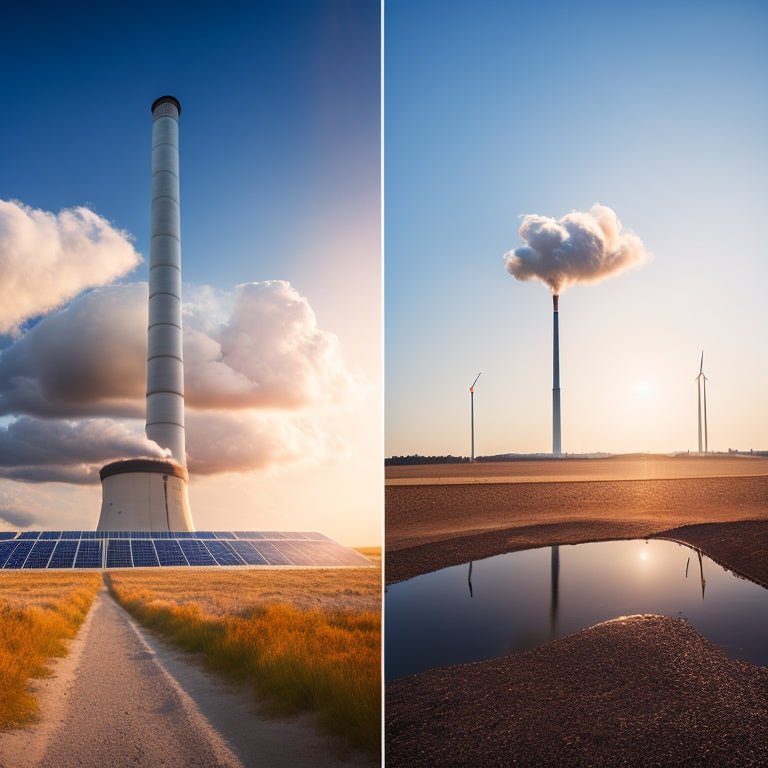
Efficiency of Solar Power Systems Vs Fossil Fuels
Share
When comparing the efficiency of solar power systems to fossil fuels, solar consistently comes out ahead. Solar systems require lower maintenance and operational costs over their lifespan, often lasting over 25 years. Fossil fuel systems, on the other hand, face significant repair costs and shorter lifespans. Additionally, solar energy reduces carbon emissions by up to 90%, addressing environmental sustainability. With rising utility rates and solar installation costs decreasing, you'll find long-term financial benefits attractive. As you investigate further, you'll uncover more understandings into why solar energy stands as a crucial choice for future energy needs.
At a Glance
- Solar power systems have lower maintenance and operational costs compared to fossil fuels, leading to long-term savings.
- Solar energy provides predictable pricing, while fossil fuel prices are volatile and influenced by external factors.
- Solar power significantly reduces carbon emissions, supporting environmental sustainability more effectively than fossil fuels.
- The initial investment for solar systems is decreasing due to technological advancements and government incentives, enhancing cost-effectiveness.
- Solar systems have a longer lifespan of 25+ years, compared to 10-15 years for fossil fuel systems, ensuring greater energy efficiency over time.
Cost Savings Over Time
When you compare solar power systems to fossil fuels, long-term financial benefits become evident.
Solar systems typically incur lower maintenance and operational costs, leading to considerable savings over time. Additionally, the potential for tax credits and rebates can greatly reduce the initial investment, making solar energy an attractive option for homeowners looking for financial incentives to switch to renewable energy sources financial incentives considerably reduce installation costs.
Long-term Financial Benefits
Solar power systems can save you considerable amounts over the long term compared to fossil fuels. By investing in solar, you're not only securing energy independence but also benefiting from substantial investment returns. Various financial incentives, such as tax credits, make solar systems more affordable upfront, enhancing your overall cost-effectiveness.
As market trends indicate a steady rise in utility rates, the potential savings from solar become increasingly attractive. Economic forecasting projects that fossil fuel costs will continue to escalate, whereas solar energy prices are expected to stabilize or decrease due to advancements in technology and grid integration. This shift can greatly impact your financial planning and risk assessment.
Moreover, there are multiple funding options available for solar investments, making it easier for you to adopt this sustainable technology. By moving to solar, you're not just minimizing your expenses; you're also positioning yourself favorably for future energy costs.
Over time, the cumulative savings from reduced utility bills can far outweigh the initial investment, reinforcing the long-term financial benefits of choosing solar power over traditional fossil fuels.
Maintenance and Operational Costs
While traditional fossil fuel systems often incur significant ongoing maintenance and operational costs, solar power systems generally require much less. With technology advancements, solar power has improved in system reliability and operational efficiency, leading to lower maintenance frequency and reduced repair costs. The service lifespan of solar panels can exceed 25 years, allowing for long-term cost savings.
Here's a comparison of maintenance and operational costs for solar and fossil fuel systems:
| Category | Solar Power Systems | Fossil Fuel Systems |
|---|---|---|
| Maintenance Frequency | Low | High |
| Repair Costs | Minimal | Significant |
| Performance Monitoring | Regular, automated | Manual, periodic |
| Installation Complexity | Moderate | High |
| Energy Storage & Grid Integration | progressing, efficient | Established, costly |
You'll find that performance monitoring in solar systems often uses advanced technologies for real-time data, reducing the need for frequent checks. In contrast, fossil fuel systems rely on manual inspections, creating higher operational burdens. Ultimately, by choosing solar, you're investing in a cleaner, more efficient energy future.
Environmental Impact Reduction
When you compare carbon emissions from solar power systems and fossil fuels, the data clearly shows a notable reduction in greenhouse gases with solar energy.
Transition to solar power greatly reduces carbon emissions and decreases reliance on fossil fuels.
Additionally, evaluating resource sustainability highlights the long-term viability of solar energy over fossil fuels, which are finite and depleting.
Understanding these factors is essential for evaluating the overall environmental impact of energy choices.
Carbon Emission Comparison
Many people may not realize the stark contrast in carbon emissions between solar power systems and fossil fuels. The data clearly shows that solar energy contributes notably less to your carbon footprint. While fossil fuels are major emission sources, releasing vast amounts of greenhouse gases, solar power generates clean energy without adding to pollution levels.
In fact, a renewable comparison indicates that solar power can reduce emissions by up to 90% compared to traditional fossil fuel sources.
As the world undergoes an energy shift, the legislative impacts favoring renewable energy technologies are becoming more evident. Government incentives and regulations are driving technological advancements that enhance solar power efficiency. These developments not only lower costs but also make solar energy a more viable option for everyday consumers.
Furthermore, by adopting solar systems, you actively contribute to reducing overall greenhouse gas emissions, helping mitigate climate change. Understanding the disparity in emissions between these energy sources is vital for making informed choices.
Resource Sustainability Assessment
The environmental impact of energy sources extends beyond carbon emissions, encompassing the sustainability of resources used in energy production. In evaluating solar power systems versus fossil fuels, a lifecycle analysis reveals critical perspectives into resource scarcity and future innovations. Technological advancements in solar energy have made it more viable, promoting energy independence and reducing reliance on depleting fossil fuels.
Here's a concise comparison of the two energy sources:
| Aspect | Solar Power Systems | Fossil Fuels |
|---|---|---|
| Resource Scarcity | Minimal, renewable | High, finite |
| Environmental Justice | Positive community impact | Often negative impact |
| Energy Equity | Accessible, scalable | Limited access |
| Grid Integration | Increasingly efficient | Requires significant upgrades |
| Policy Implications | Supports sustainable goals | Often subsidized |
As we assess the community impact, it's clear that promoting solar energy aligns with environmental justice and energy equity. The shift to solar power not only enhances technological advancements but also addresses the policy implications necessary for a sustainable future. By prioritizing solar energy, you contribute to a more equitable and resilient energy environment.
Key Advantages of Solar Energy
When considering solar energy, it's clear that its advantages stem from its renewable resource availability and low operating costs.
Unlike fossil fuels, which are finite and subject to price volatility, solar energy utilizes an abundant and consistent source of power. This not only contributes to energy security but also allows for predictable financial planning over time.
Additionally, the integration of solar battery storage systems enhances energy independence and efficiency, allowing users to store excess energy for later use, ensuring a reliable power supply even during outages energy storage systems.
Renewable Resource Availability
Utilizing the sun's energy offers a significant advantage regarding renewable resource availability. Solar resource potential is vast and largely untapped, especially when compared to fossil fuel availability, which is diminishing due to resource depletion.
While the geographic distribution of solar energy varies, most regions receive sufficient sunlight to support solar power systems. This provides a unique opportunity for energy access equity, allowing remote communities to utilize local resources without relying on centralized fossil fuel infrastructure.
However, weather dependency can influence solar energy generation, necessitating effective resource management strategies to optimize output. As policies evolve to support renewable penetration, the impact of legislation on grid integration and energy security becomes increasingly apparent.
By investing in solar technology, you're not only promoting sustainability but also enhancing energy security by reducing reliance on imported fossil fuels.
Ultimately, the shift to solar energy can help mitigate the risks associated with fluctuating fossil fuel markets while enhancing resilience against supply disruptions.
As you adopt solar energy, you're aligning with a future that prioritizes renewable resource availability, ensuring a more sustainable and equitable energy environment.
Low Operating Costs
Low operating costs represent a key advantage of solar energy, making it an increasingly attractive option for consumers and businesses alike. Unlike fossil fuels, which often involve fluctuating prices and ongoing maintenance expenses, solar power systems maintain low operating costs over their lifespan. By investing in solar technology, you can take control of your energy expenses and reduce reliance on traditional energy sources.
Here's a breakdown of the costs associated with solar energy compared to fossil fuels:
| Aspect | Solar Energy | Fossil Fuels |
|---|---|---|
| Installation Costs | Decreasing due to efficiency improvements | High and variable |
| Maintenance Costs | Minimal; only occasional cleaning | Regular maintenance needed |
| Energy Storage Costs | Lower with advances in technology | Often high and unstable |
| Operational Lifespan | 25+ years | 10-15 years |
With improved installation efficiency and advancements in energy storage solutions, solar energy is not only sustainable but also a cost-effective choice. By embracing solar power, you're making a strategic decision that aligns with both financial prudence and environmental responsibility.
Selecting Based on Energy Goals
When selecting energy sources, you need to evaluate your long-term sustainability goals and how they align with your budget.
A cost-effectiveness comparison between solar power systems and fossil fuels can provide essential understandings into which option best meets your needs.
For instance, solar power has seen a 70% reduction in installation costs since 2010, making it increasingly affordable for consumers cost-effective solution.
Analyzing the data on energy output and expenses will help you make an informed choice.
Long-term Sustainability Goals
As nations increasingly confront the realities of climate change, aligning energy strategies with long-term sustainability goals becomes fundamental.
You're likely aware that renewable energy policies must reflect sustainable development strategies to enhance energy independence initiatives. By prioritizing solar power systems, you can contribute to a sturdy framework that nurtures technological advancements.
However, it's important to acknowledge grid integration challenges that emerge with increased solar adoption. As you consider these factors, understanding social acceptance factors is essential. Engaging communities through targeted outreach and education can markedly enhance support for renewable initiatives.
Community engagement efforts not only heighten awareness but also pave the way for more effective implementation of renewable energy policies.
Moreover, employing lifecycle assessment methods will help you evaluate the environmental impacts of energy sources thoroughly. These assessments can guide decision-making, making sure that your choices align with long-term sustainability goals.
By integrating these elements into your energy strategy, you can guarantee a balanced approach that supports both ecological integrity and energy autonomy.
Ultimately, your commitment to these strategies will pave the way for a sustainable future, demonstrating the potential of solar power systems in the global energy terrain.
Cost-Effectiveness Comparison
How do you determine the most cost-effective energy source for your specific goals? Start by analyzing the initial investment required for solar power systems compared to fossil fuels. While solar may have higher upfront costs, consider the long-term savings on energy bills and the decreasing costs due to technology advancements. Market trends show a steady decline in solar installation expenses, supported by favorable financing options that can ease the initial burden.
Additionally, evaluate policy incentives that promote renewable energy, which can greatly enhance cost-effectiveness. These incentives often make solar power more attractive, particularly for those aiming for energy independence. Factor in the economic impact of grid integration, where solar can provide a resilient energy source, reducing reliance on fossil fuels.
Conduct a lifecycle analysis to assess the total costs over time, including maintenance and operational expenses. Remember, the installation processes for solar systems are becoming more streamlined, further reducing costs.
Long-Term Energy Price Stability
When considering long-term energy price stability, you'll find significant differences between solar power systems and fossil fuels.
Solar energy typically offers more predictable pricing due to its minimal operational costs and reliance on a free resource: sunlight.
In contrast, fossil fuel prices are often subject to market fluctuations, driven by geopolitical factors and supply chain issues, leading to greater price volatility.
Price Volatility Comparison
In the structure of long-term energy price stability, the contrast between solar power systems and fossil fuels reveals significant differences in price volatility.
Solar energy, fueled by advancements in technology and decreasing installation costs, offers a more predictable price path. Unlike fossil fuels, which are subject to unpredictable market trends and geopolitical tensions, solar power's costs are largely determined by the initial investment in equipment and installation. Once established, these systems benefit from minimal operational costs.
Fossil fuel prices, on the other hand, are heavily influenced by supply chain disruptions, regulatory changes, and fluctuating demand. For example, oil prices can swing dramatically due to natural disasters or political unrest, impacting energy costs for consumers and businesses alike.
In contrast, solar power systems remain insulated from such volatility, providing a stable energy price over time.
Moreover, as solar technology continues to mature, the potential for further cost reductions enhances its attractiveness. This stability not only enables consumers but also aligns with a desire for energy independence.
Consequently, when you compare the two, solar power emerges as a more reliable option for long-term energy price stability.
Frequently Asked Questions
How Do Solar Power Systems Perform in Extreme Weather Conditions?
In extreme weather, solar efficiency can fluctuate, but modern systems showcase impressive weather resilience. They're designed to withstand high winds, hail, and heavy snow, ensuring that you still capture energy even under challenging conditions.
What Maintenance Is Required for Solar Power Systems?
Like a well-tuned instrument, your solar power system needs regular care. You should prioritize solar panel cleaning and inverter maintenance to guarantee peak performance, extending the system's lifespan and maximizing your energy independence.
Can Solar Panels Generate Power at Night?
Solar panels can't generate power at night since they rely on sunlight. However, with advancements in solar panel efficiency and nighttime energy storage solutions, you can still employ stored energy to power your needs after dark.
How Does Solar Energy Storage Work?
Imagine utilizing the sun's energy even when it's absent. Solar battery technology stores this power, allowing you to manage energy effectively. It guarantees consistent access to electricity, making your energy independence a reality.
What Are the Incentives for Installing Solar Power Systems?
You'll find incentives like tax credits and installation rebates enhance your savings. Enjoy energy independence, enhanced property value, job creation, and environmental benefits, all while contributing to grid resilience and ensuring long-term savings for your future.
Explore More
To summarize, while fossil fuels may seem cheaper upfront, solar power systems can save you significant costs over time. For instance, studies show that solar energy can lead to savings of up to 70% on electricity bills over 20 years. By reducing your dependence on fossil fuels, you not only cut costs but also support a cleaner environment. As energy prices fluctuate, choosing solar provides long-term price stability, aligning with both your financial and environmental goals.
Related Posts
-

Smart Home Thermostats to Revolutionize Your Space
Smart home thermostats revolutionize your space by providing precise temperature control and optimizing energy saving...
-

Top Portable Refrigerators for Camping Adventures
When you're camping, having a reliable portable refrigerator can make all the difference for keeping your food fresh ...
-

Top-Rated Home Solar Power Kits for Achieving Energy Independence
Top-rated home solar power kits enable you to achieve energy independence by greatly cutting your energy costs. You c...


